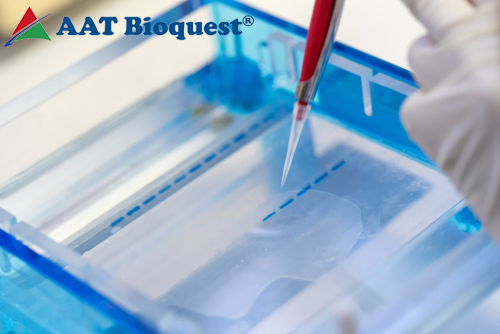Gel imaging and nucleic acid binding dyes are routinely used in life science research for the qualitative assessment of DNA fragments by electrophoresis. While ethidium bromide (EtBr) has been the primary gel stain for many years due to its low cost and sufficient sensitivity, the toxic and mutagenic hazards concerning EtBr have ultimately made it difficult to dispose of and unsafe to use.
Gelite™ Safe is specially formulated to be a considerably less hazardous alternative to EtBr for visualizing DNA in agarose and polyacrylamide gels. As a membrane-impermeant dye, Gelite™ Safe cannot penetrate living cells and bind to DNA, making the gel virtually non-cytotoxic and non-mutagenic. Furthermore, Ames testing confirms the non-mutagenicity of Gelite™ Safe over EtBr and SYBR® Green, even at concentrations well above the working concentration used for gel staining. Complementary to its safety, Gelite™ Safe provides exceptional sensitivity and versatility over EtBr and other so-called ‘safe gel stains’ that can be attributed to a combination of the dye’s unique characteristics.
Maximum Sensitivity
Alone, Gelite™ Safe is intrinsically non-fluorescent, exhibiting minimal background fluorescence in the gel. Upon binding to DNA, Gelite™ Safe exhibits a significant fluorescence enhancement several orders of magnitude greater than EtBr. Using a 300 nm UV transilluminator and ChemiDoc™ Imaging System (Bio-Rad®), as little as 0.5 ng dsDNA per band can be detected with Gelite™ Safe (Figure 1). No-wash step is necessary to achieve optimal sensitivity, and because Gelite™ Safe is specific to DNA, applications in which RNA is present in the sample will not obscure results.

Figure 1: Comparison of DNA detection in 1% agarose gel in TBE buffer using Gelite™ Safe, EtBr, and SYBR® Safe. Two-fold serial dilutions of 1 kb DNA ladder were loaded in amounts of 100 ng, 50 ng, and 25 ng from left to right. Gels were stained for 60 minutes with Gelite™ Safe, EtBr, and SYBR® Safe according to the manufacturer's recommended concentrations and imaged using the ChemiDoc™ Imaging System (Bio-Rad®). Gels were illuminated using a 300 nm transilluminator fitted with GelGreen and GelRed filters.
Enhanced Safety
Compared to EtBr and SYBR® Green, Gelite™ Safe is significantly less mutagenic, causing fewer mutations in the Ames test over the dose range from 0.2 µg/plate to 10 µg/plate in Salmonella typhimurium strain TA1538. In all of the doses, Gelite™ Safe displayed weakly positive results only after activation with S9 fraction, a liver extract. Furthermore, the membrane-impermeant properties of Gelite™ Safe prevent the dye from permeating live cells and interacting with its DNA making it virtually non-cytotoxic and non-carcinogenic. As a result of its impermeability, Gelite™ Safe is also environmentally safe, allowing quick and simple disposal.

Figure 2: Summary of Ames test results. Ames mutagenicity test was performed in a dose-dependent manner for Gelite™ Safe, SYBR® Green, and EtBr. Samples were pretreated with an S9 fraction liver extract and then tested. With S. Typhimurium strain TA1538, an increase in revertants of more than two-fold over the background indicates a positive result for mutagenicity.
Instrument Compatibilty
A significant feature of Gelite™ Safe is its broad excitation and emission profiles. Because two absorbance maxima characterize the excitation spectrum of Gelite™ Safe at ∼300 nm and ∼512 nm, it is compatible with various instruments, including UV and blue-light transilluminators, gel documentation systems, and laser scanners. More importantly, the broad emission spectrum of Gelite™ Safe allows for detection in both the green or red channels. Gelite™ Safe is compatible with EtBr, GelStar®, Gel Green, Gel Red, and SYBR® filter sets.

Figure 3: Normalized excitation and emission spectra for Gelite™ Safe DNA gel stain determined in the presence of DNA. Gelite™ Safe has excitation maxima in the UV region at 280 nm and in the visible region at 513 nm. It can be excited by instruments equipped with 254 nm (left black line), 300 nm (middle black line), or 488 nm (blue line) lasers. Gelite™ has a broad emission spectrum with a single emission maximum at 552 nm. It can be detected using either a 602/50 nm (EtBr) or 590/110 nm filter set.
Versatility
Gelite™ Safe is suitable for the detection of DNA in agarose and polyacrylamide gels. The strong DNA binding affinity of Gelite™ Safe allows for gels to be stained before or after electrophoresis without destaining. To achieve optimal sensitivity, we recommend using the post-staining method by incubating the gel in Gelite™ Safe staining solution for 30 to 60 minutes, depending upon your experimental conditions (e.g., gel thickness and composition).



